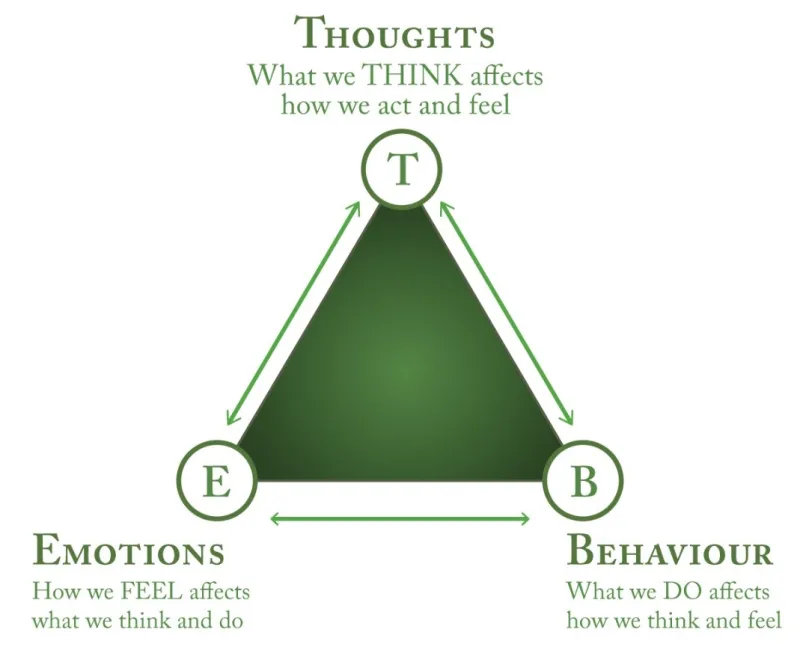If you’ve read any of my other posts on the Cognitive Behavioral Therapy Triangle, the first paragraph is the same. Feel free to skip down to after the diagram for new content or reread the initial paragraph as a refresher!
The Cognitive Behavior Therapy Triangle tells us that our behavior, emotions, and thoughts are deeply intertwined. If one of these elements is out of whack, our whole lives can begin to spiral out of control. On the flipside of that, if we work to improve just one of these factors, there’s a high likelihood for the others to improve as well.

BEHAVIOR: WHAT WE DO AFFECTS HOW WE THINK AND FEEL
Behaviors are the actions that we choose to engage in. In the context of the Cognitive Behavioral Therapy Triangle, behaviors are not stand-alone events. Rather, our behaviors affect both how we think and feel. Have you ever had a day when you weren’t feeling so great? I certainly have. What did you that day? Did you sit at home binging your favorite show? Maybe you called a friend to chat or went to the gym. Irrespective of what action you chose, your behavior impacted your thoughts and emotions (even if subconsciously). Isolating actions such as staying at home alone all weekend or ignoring friends’ messages can lead to feelings of loneliness. For some, loneliness then leads to thoughts of worthlessness. On the other hand, social interaction or even going to the gym can have the opposite effect. Social interaction and exercise enhance dopamine and endorphin release, respectively, which can lead to elevated moods. These examples aren’t hard and fast for everyone. Instead, they give a starting point for you to think about how the actions you chose affect your emotions and thoughts.
If you’re going through a particularly difficult time, here are a few steps that I’ve found helpful in using behavioral changes to affect emotions and thoughts.
1) ASSESS CURRENT BEHAVIORS
Assessing your current behaviors is the first step to understanding the effects of your behaviors on your thoughts and emotions. There are a few key questions that I want you to ask yourself: What behaviors currently define your day-to-day experience? Are these behaviors in line with your values and beliefs? How do they make you feel?
Now that you’ve taken a moment to assess your current behaviors, let’s discuss step 2.
2) DETERMINE IF BEHAVIOR CHANGES NEED TO BE MADE
When you have identified the synergy (or dyssynchrony) between your current actions and your values, you can then identify any behavioral changes that would be beneficial. If you’re typically a social person but you’ve noticed that you haven’t hung out with friends recently, maybe you can start by scheduling breakfast with a close friend. Have you noticed that you’re drinking more alcohol than you would like when you’re feeling down? Avoiding trips to the liquor store can help you to cut back. Recognizing the actions that don’t align with your values or persona can help you to understand the root of your emotions and thoughts.
3) MAKE A PLAN FOR CHANGE
Once you’ve taken the time to assess your current behavior and identify what you need to adjust, the next important step is making a plan. In step 2, I mentioned that it’s important to determine if you need to make a behavioral change. However, recognizing the need for change is not the same as actually making the change. Taking even 10 minutes to sit down and write out the changes that you plan to make can do wonders for helping you to achieve your goal.

4) ESTABLISH ACCOUNTABILITY
Accountability is central to making lasting changes. Some people are able to hold themselves accountable. Others need to reach out to a friend, family member, or therapist to help keep them on the right track. I have fallen on both ends of this spectrum at times. At times when I wasn’t going to church as often as I’d like, I turned to God to hold me accountable. When I wanted to work out more regularly, I made a workout pact with a friend. For whatever change you hope to make, finding someone to help you in that process is a sign of strength because you recognize your own shortcomings.
As I mentioned before, behaviors affect your emotions and thoughts, whether positively or negatively. Hopefully, this post helped you to get a better understanding of how you can adjust your behaviors to help realign your thoughts and emotions. By assessing your behaviors, identifying a need for change, making a plan, and establishing accountabilty, you can work toward finding a balance between your behaviors, emotions, and thoughts. If you’d like to learn more, check out my other posts below on thoughts and emotions.
POST 1 – Intro to Cognitive Behavioral Therapy Triangle
POST 2 – Emotions: What we feel affects what we think and do
POST 3 – Thoughts: What we think affects how we act and feel
The above information is my analysis of an existing psychology theory and is not intended to diagnose or treat. Please reach out to medical professionals if you or a loved one is in need of care.
National Suicide Prevention Lifeline: 1-800-273-8255
UPenn Counseling and Psychological Services (CAPS): 1-215- 898-7021
Peace and blessings,
Atasha Jordan, MD (to be)





